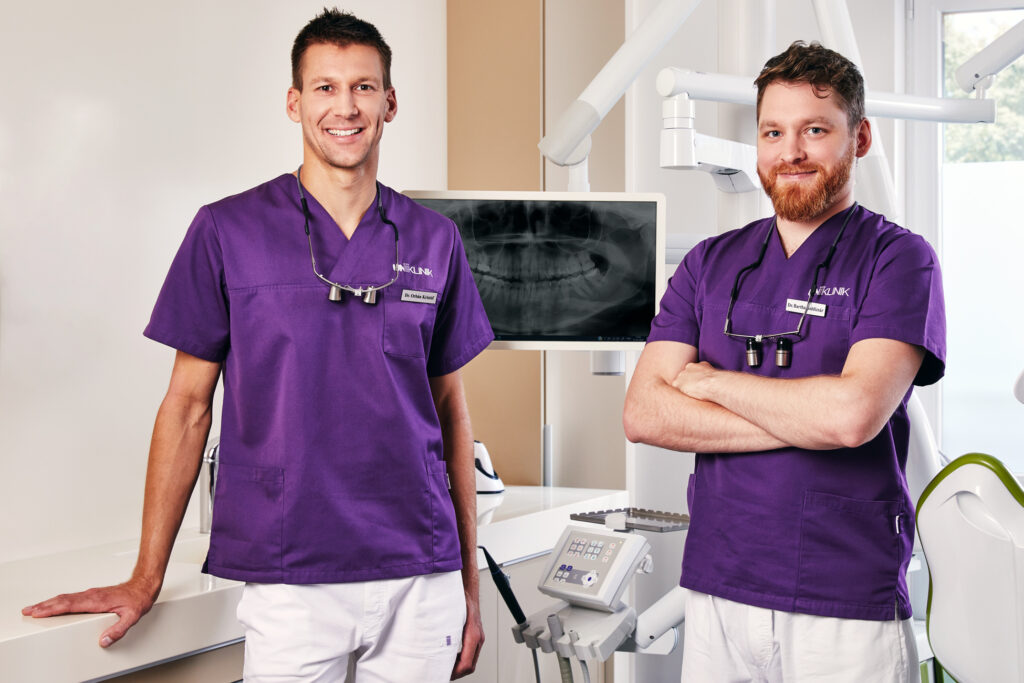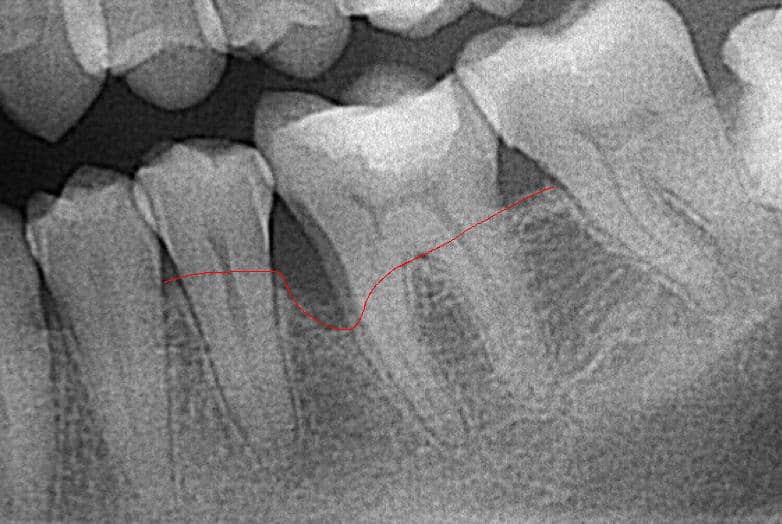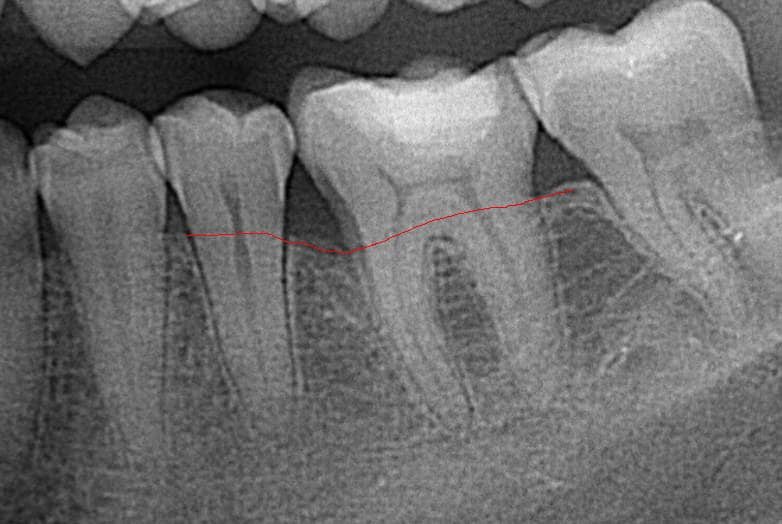
Periodontology
Irregular and improper tooth cleaning often results in poor oral hygiene, which in turn can easily lead to tooth decay and the development of periodontal disease—an issue that does not heal on its own. Without treatment, this condition can loosen the teeth, and, in the long run, tooth loss. Periodontal diseases can have various symptoms including bleeding and/or swollen gums, redness, and pain. Fortunately, modern dentistry has found solutions for nearly every dental problem including gum problems!
What is periodontology?
Periodontology is the branch of dentistry that deals with diseases of tissues supporting the teeth, including the gums, as well as their treatment.
The periodontium consists of the tissues surrounding the teeth. These include the gums, the cementum covering the tooth root surface, the bone surrounding the tooth, and the connective tissue system located between the bone and the tooth root.
During meals, plaque is continuously formed in the oral cavity. It is deposited on the surfaces of the teeth, in between teeth, and along the gum line, and if it is not removed for a long time, it can lead to damage to the periodontal tissues.
For patients who come to us, we first perform ultrasonic tartar removal, create an at-home oral care plan with the help of a dental hygienist, and then, if necessary, restore damaged tissues through various procedures. Once we achieve a balanced state in the mouth, we correct the affected area aesthetically, and help maintain a healthy condition through a joint oral care routine.
What does a periodontist do?

A periodontist is a specialist who is focused on treating gum inflammation, gum recession, and periodontal disease. They use various treatments to eliminate periodontitis (commonly known as gum recession) and restore damaged tissues.
Is your gum swollen, sensitive, or prone to bleeding when you are brushing your teeth? Have you experienced some of your teeth loosening? The former signs indicate gum inflammation, while the latter points to the presence of periodontal disease, which our expert periodontists can treat effectively.
The most common periodontal treatments
Periodontal treatments depend on the stage of the patient’s periodontal problems. In the first stage of the condition, symptoms only appear on the gums, and the process is fully reversible. The condition progresses to a more severe stage when the disease spreads to the bone surrounding the teeth. At this point, damage can be halted with timely intervention and proper treatment, but it’s important to note that not all cases can be fully reversed.
This is why we emphasize the importance of prevention, regular check-ups, and proper oral hygiene. In the early stage, thorough and regular brushing, the proper use of dental floss and interdental brushes, and mouth rinsing can be very effective. We recommend visiting your dentist for professional tartar removal once a year, and at least twice a year for routine dental check-ups!
Tartar removal
It is crucial to emphasize that tartar removal cannot be done at home, so do not attempt to remove it yourself, as you could easily damage the enamel! Tartar removal at our clinic in Budapest is performed using specialized manual instruments and an ultrasonic scaler.
As part of periodontal treatments, ultrasonic tartar removal is typically done above the gum line. The areas below the gum line are mainly cleaned using manual instruments. This method is called dental curettage, which has two types and is performed by a periodontist.

Closed curettage
During closed curettage, the cleaning of the root surface below the gum line is performed using specialized manual instruments under local anesthesia. This procedure involves the removal of inflamed tissues and infected cementum from periodontal pockets. No incision is made in the gum during this treatment; however, the disadvantage is that we do not have a clear view of the tartar and inflamed tissues located in deeper pockets.
The image below clearly shows bone loss.
The following image shows the regeneration of bone tissue six months after the regenerative surgery.
A következő képen pedig a regeneratív műtét után 6 hónappal később az elért csont visszaépülése látható.
Open curettage
Open curettage is only performed if deep periodontal pockets remain after closed curettage. During the procedure, an incision is made in the gum to access and clean the hard-to-reach root surfaces and the bottom of the periodontal pockets. After cleaning, the gum is repositioned and fixed in place using stitches. The removal of stitches typically occurs 10–14 days after the procedure.
In contrast to closed curettage, open curettage involves opening the gum, allowing us to effectively clean the affected inflamed areas.
Curettage is always performed under local anesthesia, ensuring that the procedure is completely pain-free for the patient. In cases of advanced periodontal issues, bone grafting and gum augmentation may also be part of the treatment.
Parodontológia (fogágybetegségek kezelése)
Parodontológiai konzultáció, diagnózis, kezelési terv (panoráma röntgent nem tartalmazza)
Ennek során felmérjük a fogágy és fogíny állapotát, az esetleges gyulladás súlyosságát. Az így kapott információk alapján egyénre szabott kezelési tervet készítünk pácienseink számára.
15 000 Ft
Plakkfestés, instruálás, motiválás
A megfelelő fogmosási technika kialakítása szakember által. A fogápoló eszközök hatékony használatának elsajátítása (fogkefe, fogselyem, fogköztisztító kefe). A kialakított otthoni szájápolás ellenőrzése a lepedéket megfestő tabletta segítségével. Több alkalom is lehet. Ínykorrekció, parodontális pakolás foganként.
20 000 Ft
Zárt kürett foganként
A gyulladás miatt kialakult tasakok nem műtéti kezelése. Akkor kerül sor ilyen beavatkozásra, ha a gyulladás súlyossága nem indokolja a műtéti beavatkozást, vagy műtéti beavatkozás nem végezhető valamilyen egyéb betegség, állapot miatt. Helyi érzéstelenítésben eltávolítjuk a fogak gyökerére tapadt fogköveket, majd lesimítjuk ezeket a felszíneket, illetve ezzel egy időben a gyulladásos szöveteket is eltávolítjuk a fog környezetéből. Ezt követően a kezelt területre a gyógyulást segítő anyagot helyezünk.
20 000 Ft -tól
Nyitott kürett foganként
A gyulladás miatt kialakult tasakok műtéti kezelése. Akkor kerül sor ilyen beavatkozásra, ha a gyulladás súlyossága indokolja a műtéti beavatkozást, vagy a korábbi zárt kürettett követően visszamaradt tasakokat kell megszüntetni, hogy a betegség ne újuljon ki. Helyi érzéstelenítésben lebenyt készítünk, hogy a fogak körül lévő gyulladásos szövetekhez és az íny alatti fogkövekhez hozzáférjünk. A felületeket megtisztítjuk és lesimítjuk. Majd ezt követően a lebenyt varratokkal újra egyesítjük.
52 500 Ft -tól
Membrán műtét foganként (csontpótlóval)
A fogak körül kialakult csontkráterek műtéti kezelése. Ennek segítségével növelhetjük ezen fogak stabilitását, amellett stabil gyulladásmentes állapotot érhetünk el. Helyi érzéstelenítésben lebenyt készítünk, hogy a fogak körül lévő gyulladásos szövetekhez és az íny alatti fogkövekhez hozzáférjünk. A felületeket megtisztítjuk és lesimítjuk. Majd ezt követően valamilyen csontpótló anyaggal feltöltjük a csontkrátert és a lebenyt varratokkal újra egyesítjük.
180 000 Ft
The most common symptoms of periodontal diseases
Periodontal diseases initially do not show clear symptoms, making this condition quite deceptive, as we may not experience pain for a long time. When the gums become noticeably swollen, sensitive, dark red in color, bleed during brushing, or when the gums begin to recede and teeth start to loosen, the periodontal disease has already reached an advanced stage. Typical symptoms include:
- Unpleasant breath (halitosis)
- Visible tartar build-up
- Tooth neck sensitivity, occasional pain (mild, may intensify)
- Swollen and reddish-purple gums
- Gum bleeding
- Food getting stuck between teeth
- Discharge or pus
- Gum recession, exposing the tooth roots
- Loose teeth
If you experience any of these symptoms, consult with your dentist as soon as possible so you can prevent periodontal disease or halt its advance!
What causes periodontal disease?
There are multiple categorizations for its root causes; these are the most common:
- Poor brushing technique: The primary etiological factor for periodontal disease (which means the reason which is essential for the disease’s development) is poor brushing technique, which leads to food particles sticking to the tooth surfaces, where bacteria multiply.
- Local plaque retention factors: These factors locally cause the accumulation of food debris at the gum line and beneath the gums, which diminishes the effectiveness of brushing. Examples include ill-fitting dental restorations, such as crowns and fillings that protrude or misalign.
- Genetic factors: Certain genetic traits can weaken the immune system’s ability to defend against infections, including those affecting the gums. As a result, bacteria from food particles are more likely to cause inflammation.
- External factors: Unfortunately, certain medications, such as some antihypertensive drugs and immunosuppressants, can accelerate the progression of existing periodontal disease.
Exacerbating factors
Poor oral hygiene: It is crucial to emphasize that improper brushing technique, infrequent brushing, or the use of ineffective tools can severely damage oral health.
Smoking: Smoking impairs the immune system’s defenses, and nicotine reduces blood circulation to the gums. Additionally, smoking contributes to teeth discoloration, which negatively impacts the aesthetic of your smile.
Health conditions: Uncontrolled diabetes, osteoporosis, and various immune deficiencies accelerate the progression of periodontal disease and reduce the effectiveness of treatments.
Hormonal changes: Hormonal changes in the body can intensify inflammatory symptoms, such as during puberty or pregnancy. Therefore, it is important to have a periodontal examination before planning a pregnancy and to address any existing periodontal disease. Unfortunately, during pregnancy, pre-existing periodontal disease can accelerate dramatically, and treatment options are highly limited as the fetus must be protected.
Frequently asked questions
What is periodontology?
Periodontology is a branch of dentistry that focuses on the diseases and treatment of the gums and the supporting tissues of the teeth.
What are the symptoms of periodontal disease?
Symptoms include primarily bad breath, tartar buildup, gum swelling, bleeding, recession, and tooth mobility.
What are the consequences of periodontal disease?
The most unpleasant consequence of inflamed tissues is tooth loosening, and in severe cases, tooth loss, which can unfortunately only be addressed with prosthetic replacements.
Can periodontal disease be prevented?
Yes! Proper oral care and regular dental checkups can prevent periodontal disease. In most cases, prevention is the only reliable remedy for irreversible bone damage.
Periodontology in Budapest
Periodontology in the heart of Budapest at Uniklinik Dental and Implant Center, with experts Dr. Boldizsár Bartha and Dr. Kristóf Orbán, PhD. With our online booking system, you can quickly and conveniently schedule an appointment with our periodontist specialists.






